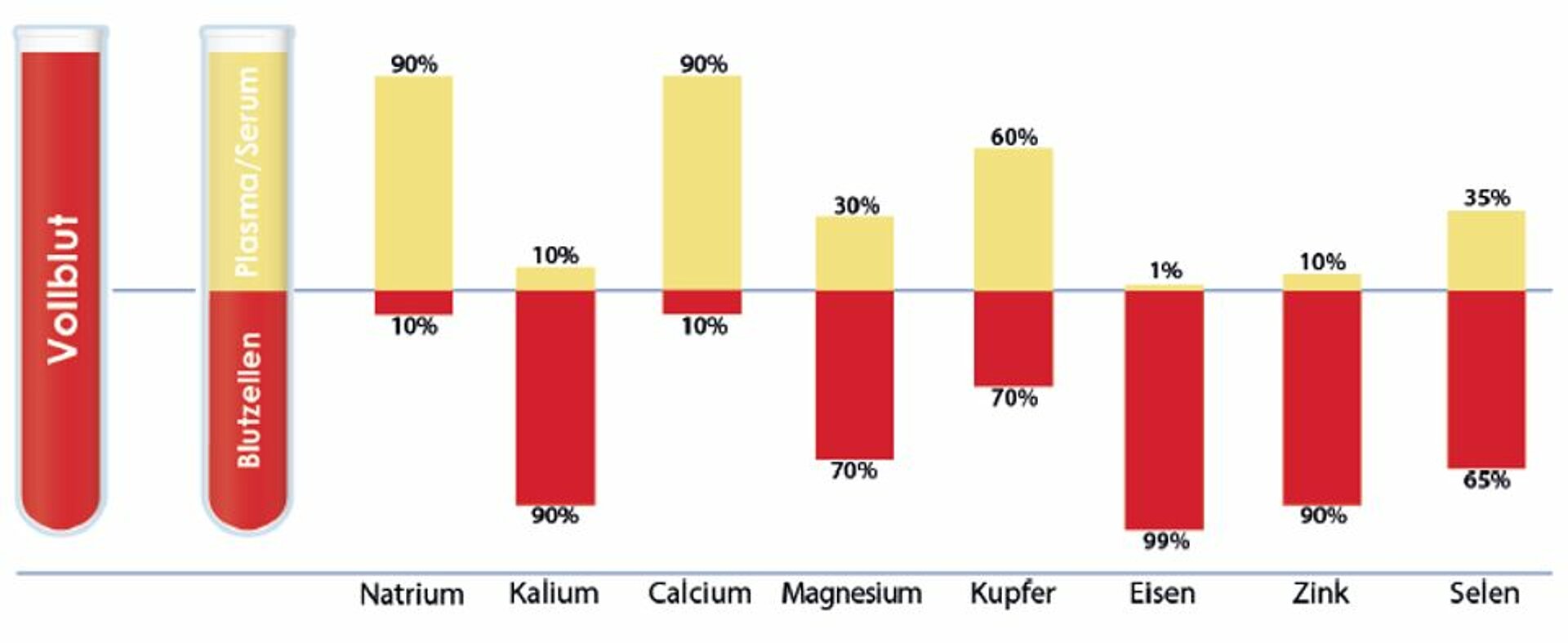Micronutrients
Micronutrients serve exceptionally important functions within the cells by acting as antioxidants, electrolytes, cofactors, or building blocks of coenzymes and hormones. Even in affluent Western industrialised societies, an optimal supply of micronutrients is not guaranteed. Various factors – commonly summarised under the term ‘lifestyle’ – may result in micronutrient deficiencies, including:
- A one-sided or unbalanced diet
- Alcohol, cigarette, or drug abuse
- Environmental pollution
- Physical and psychological stress
- (disease-related) impairments in absorption, distribution, storage, or excretion
Therefore, monitoring micronutrient status through appropriate laboratory diagnostics represents an important tool for ensuring physiological processes.
Table: Overview of the most important minerals
Nutrients | Functions/Properties | Food Sources | Deficiency Symptoms |
Calcium | Mineralization of bone tissue and tooth structure, muscle contraction, transmission of nerve impulses, blood clotting | Milk (and dairy products), green vegetables such as spinach or broccoli, legumes, nuts, calcium-rich mineral water | Muscle cramps (tetany), disturbances in bone metabolism (osteomalacia, rickets, osteoporosis), paresthesia in fingers and toes |
Iron | Transport and storage of oxygen, synthesis of erythrocytes, electron transfer, various oxidation and reduction reactions | Liver, meat, whole grain products, legumes, oats, pumpkin seeds, amaranth, flaxseed, quinoa, pistachios, apricots, spinach | Fatigue, poor concentration and learning ability, sensitivity to cold, pale skin, hair loss, susceptibility to infections, growth disorders, hypochromic microcytic anemia |
Iodine | Thyroid hormones, cell growth, regulation of energy metabolism | Sea fish, shellfish, iodized table salt, milk (and dairy products) | Poor concentration, hearing defects in newborns, goiter, fertility disorders, sleep disturbances |
Potassium | Excitation of nerve and muscle cells, blood pressure regulation, acid-base balance, activation of enzyme systems (e.g. glycolysis) | Apricots, bananas, kohlrabi, tomatoes, potatoes with skin, nuts, whole grain products from spelt, rye, and buckwheat | Muscle weakness and cramps, paresthesia, constipation, cardiac arrhythmias, latent acidosis, reduced insulin sensitivity |
Copper | Iron metabolism, antioxidant protection, mitochondrial respiratory chain, cellular oxygen utilization | Organ meats, shellfish, nuts, cocoa, coffee, tea, legumes, whole grain products | Weakness, fatigue, connective tissue defects, growth disorders, hypochromic microcytic anemia |
Magnesium | Regulation of nerve and muscle cell excitability, involvement in bone mineralization, cardiovascular system support | Whole grain products, wheat germ, oats, nuts, green vegetables like Brussels sprouts, berries, magnesium-rich mineral water | Tingling, muscle weakness, tremors, cramps, cardiac arrhythmias, numbness, exhaustion, immune dysfunctions, behavioral problems (especially in children) |
Sodium | Maintenance of osmotic pressure, conduction of nerve and muscle impulses, blood pressure regulation, acid-base balance | Table salt, processed foods (e.g. bread, cheese, sausages, canned fish, seasoning sauces)
| Thirst, headaches, dizziness, muscle weakness and cramps, low blood pressure |
Selenium | Antioxidant protection, immune modulation, anti-carcinogenic effects, thyroid hormone metabolism, cell division | Meat, fish, eggs, Brazil nuts, cruciferous vegetables (e.g. broccoli), garlic, onions, mushrooms, asparagus, legumes | Susceptibility to infections, fatigue, thyroid hormone dysfunction, myopathies |
Zinc | Developmental, growth and regeneration processes (e.g. wound healing), cell differentiation, immune competence, antioxidant function, hormone metabolism (e.g. insulin) | Meat, oysters, eggs, milk (and dairy products), nuts (e.g. cashews), wheat germ and bran, legumes (especially lentils), oats | Loss of appetite, hair loss, impaired wound healing, taste and smell disorders, susceptibility to infections |
Immunogenic Function
Micronutrients are involved in all immune responses and closely interact with one another in their effects. A deficient micronutrient status is among the most important causes of increased susceptibility to infections. Optimising micronutrient supply already plays a key role in the prevention of infections. This approach is well established for vitamins A, B2, B6, C, E, pantothenic acid, and folic acid, as well as for the minerals iron, copper, magnesium, selenium, and zinc. However, relevant interrelationships must also be considered in relation to the risk of complications in patients who are already suffering from illness, as well as their recovery. An acute infection has significant nutritional consequences and can exacerbate or trigger deficiencies to a considerable extent. The situation is particularly critical if a deficiency was already present prior to the infection.
Micronutrients – Whole Blood Diagnostics
In contrast to serum diagnostics, the determination of mineral status in whole blood also includes the erythrocyte cell mass. An increase in haematocrit, for example, leads to a rise in intracellular element concentrations. Therefore, it is advisable to relate the measured micronutrient levels to the concurrently determined haematocrit levels and to present these individually in the report.
This applies to the following elements:
- Iron
- Potassium
- Copper
- Magnesium
- Selenium
- Zinc
By contrast, a correlation with haematocrit is not meaningful for extracellular elements such as sodium and calcium, as their concentrations are not affected by haematocrit levels.
Erythrocyte = red blood cell
Haematocrit = proportion of blood volume occupied by blood cells (How think or thin is the blood?)

